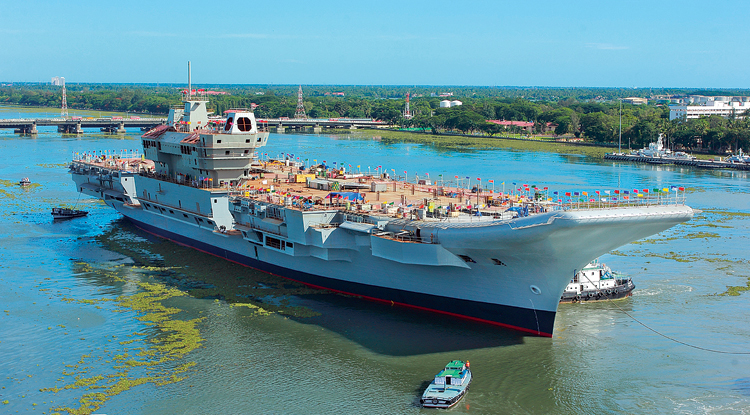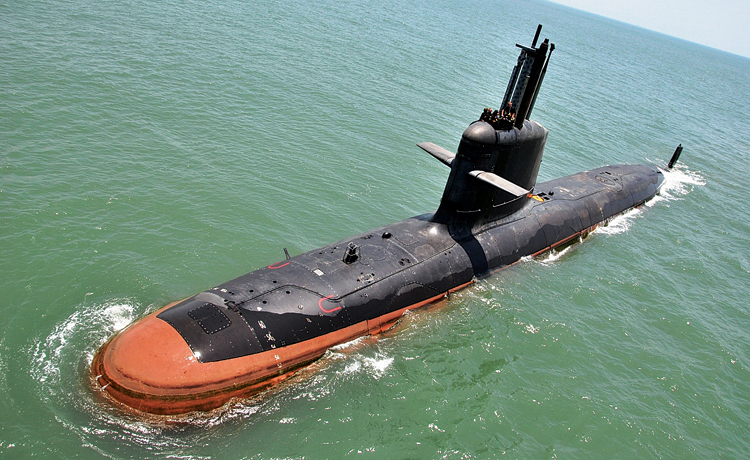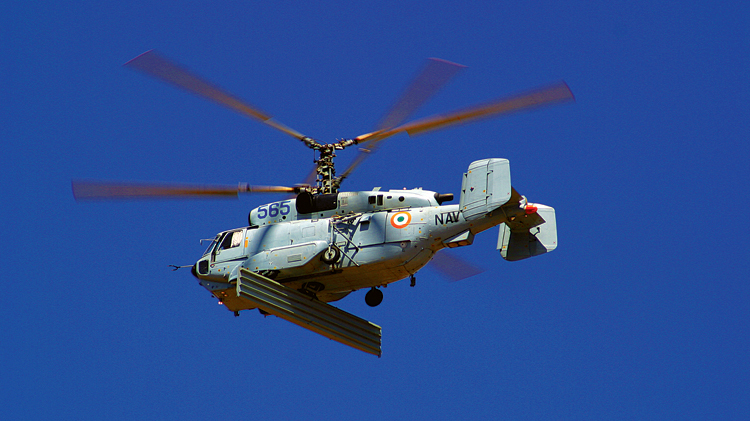INDIAN ARMED FORCES CHIEFS ON
OUR RELENTLESS AND FOCUSED PUBLISHING EFFORTS

SP Guide Publications puts forth a well compiled articulation of issues, pursuits and accomplishments of the Indian Army, over the years

I am confident that SP Guide Publications would continue to inform, inspire and influence.

My compliments to SP Guide Publications for informative and credible reportage on contemporary aerospace issues over the past six decades.
Cover Story
Indian Navy's Acquisition and Modernisation Plans
Despite the severe setbacks especially in submarine build-up plan causing serious capability gaps, Indian Navy’s acquisition and modernisation plans, spanning over three plan periods 2005-2022 are well on track, although some prestigious projects have missed the delivery milestones

In support of the nation’s growing strengths and responsibilities, the Indian Navy is determined to create and sustain a three dimensional; technology enabled and networked force capable of safeguarding our maritime interests on the high seas and projecting combat power across the littoral.
The Indian Navy’s Maritime Military Strategy which flows from the above “Vision Statement” has adopted a generic capability building approach. Introducing the Vision, it stipulates, “The Indian Navy is today a potent and capable force which is highly regarded for its professional competence. The planned induction of advanced platforms and technology, and creation of modern infrastructure, promise to boost the capabilities of the Service even further in the near future”.
Indian Navy’s Maritime Capability Perspective Plan
Aircraft Carrier Programme. The acquisition of extensively refitted and modernised, former Russian ICBM carrier Admiral Gorshkov, commissioned as INS Vikramaditya has added new dimension to blue water capability of Indian Navy. INS Vikramaditya is currently the sole aircraft carrier engaged in extensive flying operations with MiG 29K aircraft as the sole fixed wing fighter into her Air Wing.
Construction of prestigious 37,500 tonnes Indigenous Aircraft Carrier (IAC-1) is on track and is likely to be commissioned by 2020. Vikrant would embark a mix of 30 aircraft, including MiG-29Ks and rotary wing assets to include KA-31, Airborne Early Warning (AEW) helicopters. Fixed wing aircraft operations would be based on Short Take-Off but Arrested Recovery (STOBAR) concept on an angled flight deck with a 12 to 14° ski-jump.
Considering the complexity of design development and construction, systems integration, the gestation period for IAC-2 to be christened as INS Vishal, could well span over 10-15 years. It is learnt that IAC-2 of 65,000-tonne will have a conventional propulsion system with Catapult Assisted Take-off But Arrested Recovery (CATOBAR) which would offer flexibility for launching fighters as well as heavier aircraft for surveillance, early-warning, electronic warfare and other operations.

Projects 17 & 17A. All four ships of Project 17 stealth frigates built by MDL have been commissioned. These ships are capable of carrying two advanced multi-role helicopters. Project 17A comprises seven stealth frigates with advanced features and technology upgrades is a follow-on programme of Project 17. The construction load of Project 17A will be shared between MDL for four ships and GRSE for three ships.
Projects 15A & 15B. Project 15A comprising three follow-on Delhi class guided missile destroyers have been named as the Kolkata Class. The second and third ships have been named as Kochi and Bengaluru. These ships are considerably different from its predecessors with the incorporation of stealth features and advanced technologies. Major changes include the fitment of up to 16 vertically launched BrahMos missiles and the Barak NG, LR-SAM jointly developed by DRDO with Israel’s IAI, as also new sensors. The Government has also approved an additional four ships of the same class to be designated as Project 15B and to be constructed at MDL.
Project 1135.6-Talwar Class. Three follow-on Talwar class GM frigates were commissioned as INS Tej, Tarkash and Trikand. The major change in the new series of stealth frigates is replacement of the Klub missiles with BrahMos system. There are reports of possible acquisition of additional three ships of the same class to be constructed in Russia and brought to India for integration of propulsion, weapons and ancillary systems, possibly at Goa Shipyard Ltd.
Project 28 ASW Corvettes. Four new stealth ASW corvettes indigenously designed, built by GRSE, Kolkata, have been commissioned. At 2,500 tonnes and designed for a minimised signature profile to provide stealth capability, these ships would considerably augment the Navy’s ASW capability.
Mines Counter Measures Vessels (MCMVs)
The Defence Acquisition Council has given the go-ahead to Goa Shipyard Ltd (GSL) for the construction of all eight MCMV with the option of additional ships, under Strategic Partnership model. The project is to replace 12 aging Pondicherry and Karwar class minesweepers by 2020. Indian Navy requires at least 24 MCMVs to clear mines laid by enemy warships and aircraft to blockade harbours during war.
Shallow Water ASW Crafts
Government has approved induction of 16 shallow water ASW crafts to be indigenously built and the procurement process for the same is underway.
Amphibious Capability
With the induction of the landing platform dock (LPD) Jalashwa, Indian Navy has considerably augmented its amphibious capability. Together with the five landing ship tanks (Large), a sealift capability for over 3500 troops and a squadron of armour now exists. To augment its amphibious lift capability, Indian Navy is now looking to build larger amphibious ships of the LPD variety. This project will be pursued through external design collaboration on the model for the IAC project. The case for four multi-role landing platform docks is being progressed with two private shipyards – L&T and Reliance Naval and Engineering Ltd. The contract is expected to be concluded shortly.
Considering the complexity of design development and construction, systems integration, the gestation period for IAC-II to be christened as INS Vishal, could well span over 10-15 years
Fleet Support Ships
The 2008 order for a fleet tanker on Italian Shipbuilder Fincanterri had a followon option of up to three tankers. Indian Navy has now exercised this option for one follow-on ship. The induction of two ships would enable Indian Navy to ensure the availability of at least three such Fleet Support ships at any time. Government has also approved induction of five fleet support ships to be indigenously constructed.
Submarine Arm
Scorpene Project 75. The first project under the perspective plan was Project 75, Scorpene for indigenous construction of six conventional stealth submarines under transfer of technology arrangements with DCNS, France (now Naval Group). After the delay of more than a decade and numerous controversies the first of line of the project, INS Kalvari, an attack stealth submarine was commissioned on December 14, 2017. As per available reports the delivery of all six boats is expected to complete by 2021.

Modernisation Plan. Modernisation and upgrading of capabilities of 877EKM class and HDW, Shishumar class submarines were undertaken. The modernisation entailed service life extension as also upgrading the capabilities of the relatively newer submarines of the class. For instance, retro-fitment of torpedo-tube launched missile system with anti-shipping and land attack versions provided teeth to 877EKM submarines. Likewise, all major machineries, auxiliaries, propulsion system, sensors, etc. either underwent major overhaul or replaced with advanced versions to extend the operational life until year 2025.
Project 75 (India). Project 75 (India) is a sequel to Scorpene Project 75 to boost the ethos of self-reliance through indigenisation. Project 75 (India) was resuscitated and the Government promulgated RFI in early 2017. Global RFI was issued to six leading shipbuilders; Naval Group, France (former DCNS), ThyssenKrupp Marine Systems, Germany, Rosoboronexport-Rubin Design Bureau, Russia, Navantia, Spain, Saab, Sweden and the Mitsubishi-Kawasaki Heavy Industries Combine, Japan to participate in building six advanced stealth submarines at an estimated 70,000 crore ($10.9 billion) in collaboration with an Indian shipyard. In tandem Indian Navy will formulate the Naval Staff Qualitative Requirements before the formal RFP is issued. The six diesel-electric submarines conceived under Project 75 (India) are to be fitted out with land-attack cruise missiles, air-independent propulsion for greater underwater endurance, and the capability to integrate indigenous weapons and sensors as and when these are developed. Mitsubishi-Kawasaki Heavy Industries Combine, Japan and Navantia, Spain have however, declined to respond to RFI. There is a long and tedious road ahead for the project to fructify. In the first stage capability assessment of the Indian shipyard which has capability of entering into Strategic Partnership with foreign collaborator will be undertaken. This process of selection could take as much as two years to complete. Thereafter the technical evaluation, commercial bids evaluation, cost negotiations, contract finalisation, etc. Hence, even if the project is fast-tracked, the first submarine cannot be expected before the year 2027.
Nuclear Powered Submarines. For strategic deterrence India needs at least six nuclear powered attack submarines (SSN) and four nuclear powered submarines with nuclear-tipped missiles (SSBN). In February 2015, Government of India approved the construction of six SSNs. The first indigenous SSBN INS Arihant was commissioned in 2016. Under a classified programme three more SSBNs are under construction. The timelines for six SSNs and three SSBNs are not available. In addition to INS Chakra there are plans to lease second SSN from Russia for 10 years under $1.5 billion deal.
Naval Aviation
Carrier Borne Multi-Role Fighters. Along with the acquisition of INS Vikramaditya fourth generation Mikoyan, MiG-29K, multirole fighter was inducted which is now the centrepiece of the Air Wing of Vikramaditya. Accordingly, MiG-29K and Tejas (Navy) were earmarked as Air Wing for under construction IAC-1, Vikrant. However, in lieu of Tejas (Navy), Indian Navy has begun a search for a multi-role carrier borne fighters (MRCBF) for IAC-1 and its follow-on. The RFI has elicited enthusiastic response from all leading global manufacturers to answer queries on technical parameters, budgetary estimates, likely level of indigenisation, transfer of technology and schedule of deliveries after a contract is inked. French, Swedish, Russian and American firms have been served the RFI for the project to equip IAC-1, Vikrant and IAC-2.
RFI required details whether the aircraft is single or twin-seat (or available as both), and if it has one or two engines; whether it can perform short take-off but arrested recovery or catapult assisted takeoff but arrested recovery operations (or both); whether the aircraft is already in operational use or not; whether helmetmounted displays and large-area displays are integrated and fitted; is auto-landing an option; and whether or not an active electronically scanned array radar is fitted.
It is a matter of national pride that Indian Navy has showed the way how best the advanced and technology intensive platforms from diverse sources could be acquired, absorbed and optimally exploited to augment its operational capabilities to emerge as a Blue Water Navy in true sense
Currently, six aircraft are compatible, namely; Dassault’s Rafale, Boeing’s F/A-18 Super Hornet, Russian MIG-29K, Lockheed Martin F-35B and F-35C, and Gripen from Saab, Sweden. While F/A-18, Super Hornet, Rafale and MIG-29K are twin engine jets, the remaining three have single engine. Responses received to RFI are being evaluated. RFP is expected to be promulgated by mid-2018 and the induction timelines will be aligned with the operationalisation of IAC-1.
Maritime Patrol and Reconnaissance. A true game-changer and most technologically advanced and intensive platform Boeing, Poseidon P-8I, Long-Range Maritime Reconnaissance & Anti-Submarine Warfare Aircraft (LRMR & ASW) has been most successfully inducted. The Indian Navy is truly proud with the inventory of P-8I aircraft gradually swelling to 12 aircraft, with possibility of additional 12 aircraft acquired in due course.
In order to bridge the gaps within the spectrum of surveillance and reconnaissance domain this spectrum has been further bifurcated into medium range maritime reconnaissance (MRMR) and shortrange maritime reconnaissance (SRMR). The acquisition process for nine yet to be identified MRMR aircraft is in the works with no definite timelines for its availability.
Naval Utility Helicopters. Indian Navy is facing acute shortage of naval utility helicopter (NUH) for replacing its aging fleet of Chetak helicopters for the frontline frigates and offshore patrol vessels with small-decks and aircraft carriers, as also for the shore based flights to extend support out at sea for the smaller ships not designed to carry NUH.
Acceptance of Necessity for procurement of 111 NUH worth 21,738 crore ($3.2 billion) was accorded by the Defence Acquisition Council under the Strategic Partnership model to give a major boost to indigenous defence manufacturing capabilities in the country, especially in the Naval Aviation segment.
RFP is expected to be issued shortly to original equipment manufacturers (OEM) for the first 16 helicopters to be imported in flyaway condition, with the balance 95 to be manufactured in India by an Indian manufacturer in partnership with the selected global OEM. Likely OEMs to participate in the Tender are; Eurocopter’s AS565 Panther, Sikorsky’s S-76B, and a maritime version of AgustaWestland’s AW109 Koala. Bell and Russian Helicopters could also offer own product.
Naval Multi-Role Helicopters. Indian Navy plans to acquire 123 Naval Multi-Role Helicopters (NMRH) to be used as ship borne flights of two helicopters each for its frontline destroyers and frigates to form integral air for critical operations out at sea. RFI for NMRH was floated by MoD globally on August 22, 2017. Apart from NH90, contenders for NMRH bid could include the Lockheed Martin/Sikorsky MH-60R and Eurocopter’s EC 725 Caracal.

Advanced Early Warning Helicopter. Acquisitions of Russian make Kamov. Ka 31, an advance early warning (AEW) helicopter, nearly a decade and a half ago has enhanced the AEW capability of the Indian Naval Aviation considerably. Inventory of Ka 31 is being augmented gradually.
Future Projects
Following futuristic programmes are under active consideration of the Indian Navy:
- Next-generation destroyers
- Next-generation frigates
- Next-generation corvettes
- Nex-generation MCMVs
Conclusion
Despite the severe setbacks especially in submarine build-up plan causing serious capability gaps, Indian Navy’s acquisition and modernisation plans, spanning over three plan periods 2005-2022 are well on track, although some prestigious projects have missed the delivery milestones. All of naval platforms are hugely technology intensive and thus extremely complex in nature, as a consequence suffer from long and sometimes unpredictable gestation periods in fruition. Challenges of technology induction and absorption, time and cost over-runs can only be embattled by efficient and accountable decision making processes and mechanism at all levels, especially at the Government echelon.
Nevertheless, Indian Navy has impeccable record of proudly marching the indigenous path of self-reliance for its force accretion and development. It is a matter of national pride that Indian Navy has showed the way how best the advanced and technology intensive platforms from diverse sources could be acquired, absorbed and optimally exploited to augment its operational capabilities to emerge as a Blue Water Navy in true sense.





